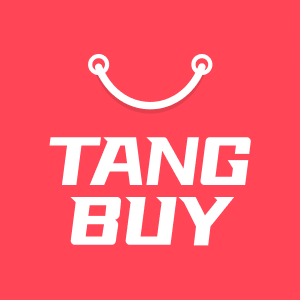Dropshipping Expenses: Everything You Need to Know
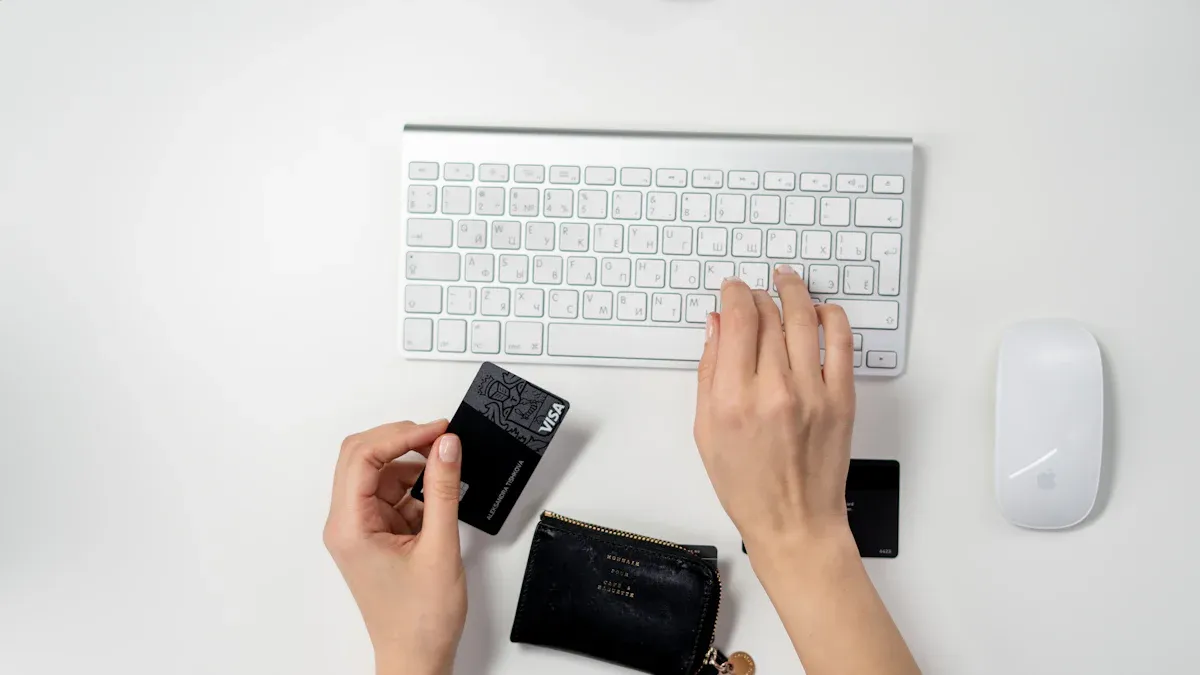
So, how much does dropshipping really cost? Some people say it is cheap to start. But Dropshipping Expenses can grow fast. You must pay for your domain, hosting, marketing, platform fees, and good suppliers. Here are some common expenses you should expect:
Domain and hosting: £10–£50 each year for a domain, £3–£10 each month for hosting
Marketing: Paid ads, social media, and influencer costs
Platform and transaction fees: Monthly subscriptions plus 2–3% per sale
Customer service: Virtual assistant support
Shipping and returns: These change by order and location
Many new sellers do not see hidden costs. It is smart to plan ahead and save a bit extra for surprises.
Key Takeaways
When you start a dropshipping business, you must plan for costs. These include domain, platform fees, marketing, and suppliers.
Pick your platform with care. Shopify has monthly and transaction fees. WooCommerce needs hosting and plugins.
Good branding is important. A simple logo and theme help build trust. They also make your shop look professional.
Always order product samples first. This lets you check the quality. It stops you from selling bad items. Bad items can hurt your reputation.
Watch out for hidden fees from suppliers and platforms. Payment providers may also have extra fees. These can lower your profits.
Use apps and tools only when needed. Start with just what you need. This keeps your monthly costs low.
Plan for shipping and returns costs. Make clear policies for refunds. This helps protect your earnings.
Keep a detailed budget and track all expenses often. Change your prices if needed to stay profitable as your business grows.

Startup Costs
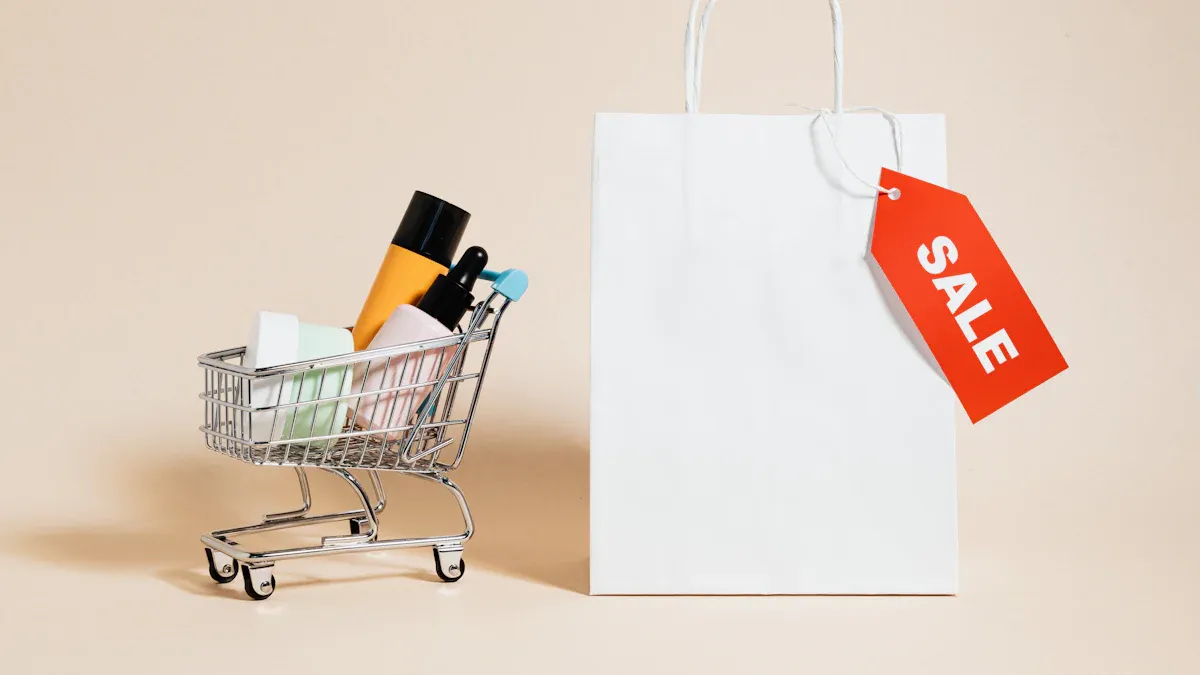
Starting a dropshipping store does not have to break the bank, but you do need to plan for some key expenses. Let’s look at the main costs you will face before you launch.
Platform Fees
Choosing the right platform is your first big step. Most people pick either Shopify or WooCommerce. Each has its own fee structure.
Shopify
Shopify is popular because it is easy to use and comes with lots of features. You pay a monthly fee and a small charge for each sale. Here’s a quick look:
Shopify Plan | Monthly Fee | Transaction Fee (Shopify Payments) |
|---|---|---|
Starter | $5 | 2.9% + $0.30 per sale |
Basic | $39 | 2.9% + $0.30 per sale |
Shopify | $105 | 2.6% + $0.30 per sale |
Advanced | $399 | 2.4% + $0.30 per sale |
If you use a different payment gateway, Shopify charges an extra fee. Most new stores start with the Basic plan, which is about £36 per month.
WooCommerce
WooCommerce is a free plugin for WordPress. You do not pay a monthly fee for the platform itself, but you do need to pay for hosting and any extra features you want.
Cost Item | Typical Price |
|---|---|
Hosting | £4–£20 per month |
Premium Plugins/Themes | £25–£80 (one-time) |
Transaction Fees | 2.9% + fixed fee |
WooCommerce gives you more control, but you may spend more time setting things up.
Domain Name
You need a domain name so customers can find your shop online. Most domains cost between £10 and £15 per year. If you buy your domain through Shopify, privacy protection is included for free. If you use a third-party service like GoDaddy, you might pay as little as £1 for the first year, but renewal and privacy fees can push the price up to £20 or more each year.
Tip: Always check if privacy protection is included. It keeps your personal details safe.
Business Registration

You should register your business before you start selling. In the UK, you can register as a sole trader or a limited company. The cost is very low—sometimes even free if you register as a sole trader. In the US, registration fees can be much higher, often around $238 (about £190) depending on the state. Registering your business makes you look more professional and can help with opening a business bank account or getting a company credit card.
Planning ahead for these costs helps you avoid surprises. Most new dropshipping stores start with an initial investment of £50–£100, but having a little extra set aside is always a good idea.
Branding
Branding helps your shop stand out. When you start a dropshipping business, you want people to remember your store. Good branding makes your shop look trustworthy and professional. You do not need to spend a fortune, but you should plan for some basic branding costs.
You will need a logo. A logo is like your shop’s face. It shows up on your website, emails, and even your packaging if you decide to add custom touches later. You can get a simple logo for as little as $15 if you use sites like Fiverr. If you want something unique or more detailed, you might pay up to $300. Some people use free tools like Canva to make their own logo. This can save money, but it takes a bit more time.
Next, think about your store’s look and feel. This means picking a theme and maybe changing some colours or fonts. Most ecommerce platforms offer free themes, but you might want to buy a premium theme or pay for custom tweaks. Customising your store’s theme usually costs between $100 and $300. This covers things like layout changes, banners, and making your site match your brand colours.
Here’s a quick table to show typical branding costs:
Branding Expense | Typical Cost Range (USD) | Notes |
|---|---|---|
Logo Design | $15 - $300 | Fiverr offers logos from $5 to $75; 99designs starts at $299 for crowdsourced designs. |
Store Theme Customisation | $100 - $300 | Covers website design and theme tweaks. |
Branding & Design (one-time) | $0 - $50 | Includes logo, theme, and product images via Canva or Fiverr. |
You might wonder if you can skip branding at first. You can, but even a basic logo and a clean theme help build trust. Customers feel safer buying from a shop that looks real. If you want to keep costs low, start with a free logo maker and a simple theme. Upgrade later when you have more sales.
Tip: Try to keep your branding simple and clear. Too many colours or fancy fonts can make your shop look messy. Pick two or three colours and stick with them.
Branding is a one-time cost for most new stores. You can expect to spend anywhere from nothing to about $350, depending on your choices. If you use free tools and do it yourself, you might only spend your time. If you hire a designer or buy a premium theme, set aside a bit more in your budget. Planning for branding now saves you from rushing to fix your shop’s look later.
Dropshipping Expenses Breakdown
Product Sourcing
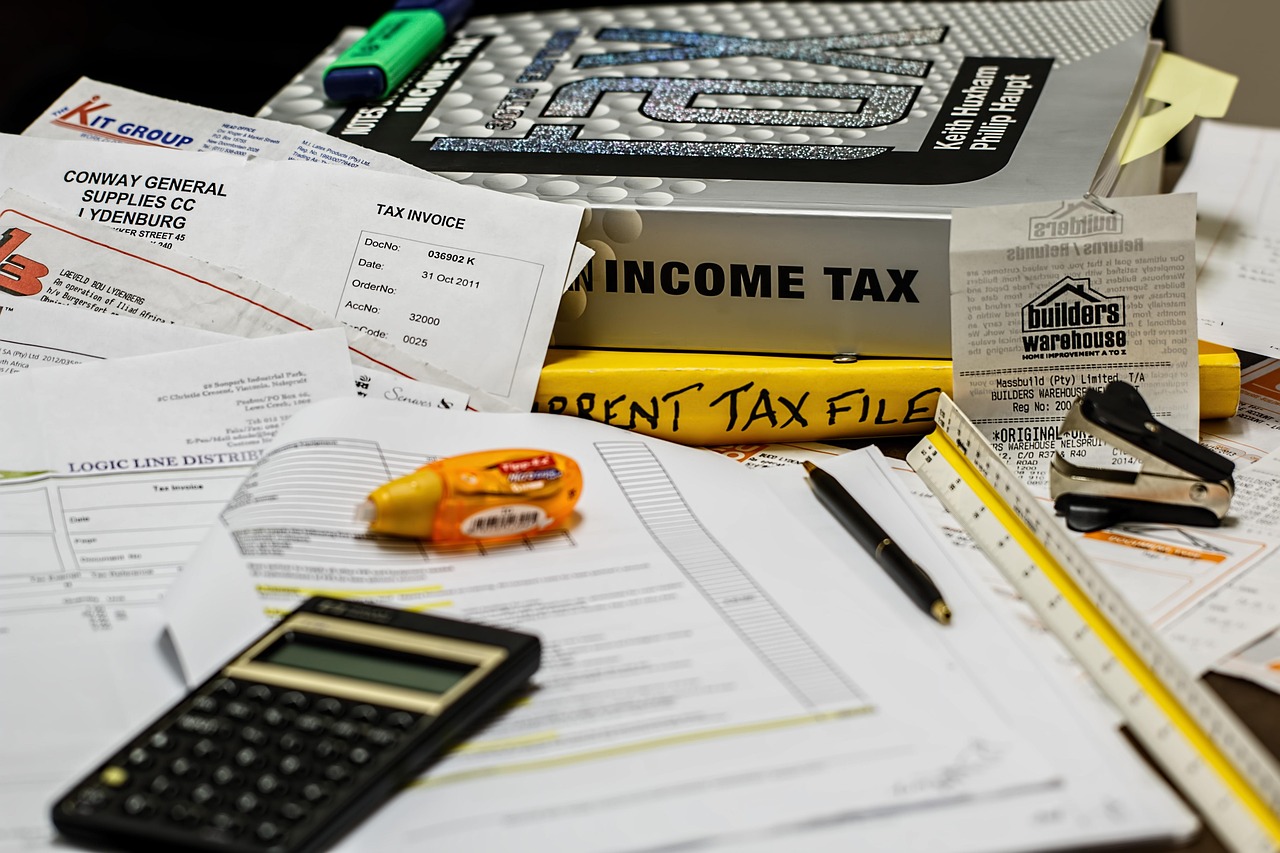
You have many ways to source products for your dropshipping store. Each method comes with its own costs and benefits. Here are the most common options:
Wholesale and Dropshipping Platforms: Sites like AliExpress, SaleHoo, and Wholesale2B let you pick from thousands of products. You pay the supplier’s price for each item. Some platforms charge extra fees for access or premium features.
Private Label Products: You can order products with your own branding. For example, you might buy skincare items with your logo. These usually cost less per unit if you buy more at once, but you need to meet a minimum order. This method works well if you want to build a unique brand.
Print on Demand (POD): This lets you sell custom designs on items like t-shirts or mugs. You do not need to buy stock upfront. Suppliers like Printify make and ship each item as orders come in. Prices depend on the product and print quality.
When you choose a sourcing method, think about upfront costs, order size, and how much control you want over your brand. Print on demand is great if you want low risk and no inventory. Private label works best if you plan to scale and want lower costs per item.
Tip: Always check for extra fees like shipping, platform charges, or premium options. These can add up and affect your profit.
Supplier Fees
Suppliers often charge more than just the product price. You might see extra costs that can catch you off guard if you do not plan ahead. Here are some common supplier fees:
Membership or Subscription Fees: Some platforms ask you to pay monthly or yearly to access their products. For example, SaleHoo charges a yearly fee for its directory.
Order Fees: Many suppliers add a fee for each order they process. This can range from £2 to £15 per order, depending on the supplier and product.
Shipping Fees: Costs depend on the item’s size, weight, and where it is going. Fast shipping usually costs more.
Management and Packaging Fees: Some suppliers charge for special packaging, branded inserts, or handling.
Inventory Storage Fees: If you use a supplier that holds stock for you, they may charge storage fees.
You should always read the fine print before you choose a supplier. Some fees are easy to miss. If you do not factor these into your prices, you might lose money on each sale.
Fee Type | Typical Range | Notes |
|---|---|---|
Membership/Subscription | £20–£70/year | For access to supplier directories |
Per Order Fee | £2–£15/order | Varies by supplier and product |
Shipping | Varies | Based on weight, speed, and location |
Packaging/Management | £1–£5/order | For branded or special packaging |
Inventory Storage | £10–£50/month | If supplier stores your products |
Note: Some suppliers offer discounts if you order in bulk or pay for a higher membership tier.
Product Sampling
Before you start selling a new product, you should always order a sample. Product sampling helps you check the quality, test shipping times, and see how the supplier handles orders. This step can save you from big problems later.
Product sampling costs can vary:
Some suppliers let you order single items at the normal price. AliExpress is good for this, as you can buy one product without a minimum order.
Other platforms, like Alibaba, may ask for a minimum order but often allow you to buy one sample first.
Some services, such as Spocket, let you order up to five samples per product.
Sampling usually costs the same as buying the product, plus shipping. Sometimes, suppliers offer free samples, but you still pay for delivery. Expect to spend anywhere from £5 to £30 per sample, depending on the product and where it ships from.
Why is sampling so important? You get to see and feel the product yourself. This helps you write better descriptions and take your own photos. You can also spot any quality issues before your customers do. If the sample is not good, you avoid selling a product that could hurt your shop’s reputation.
Tip: Always talk to your supplier before ordering a sample. This helps you judge their communication skills and reliability.
Testing products before you list them in your shop protects you from costly mistakes. It also helps you build trust with your customers. If you skip this step, you risk bad reviews, returns, and wasted money.
Order Fees
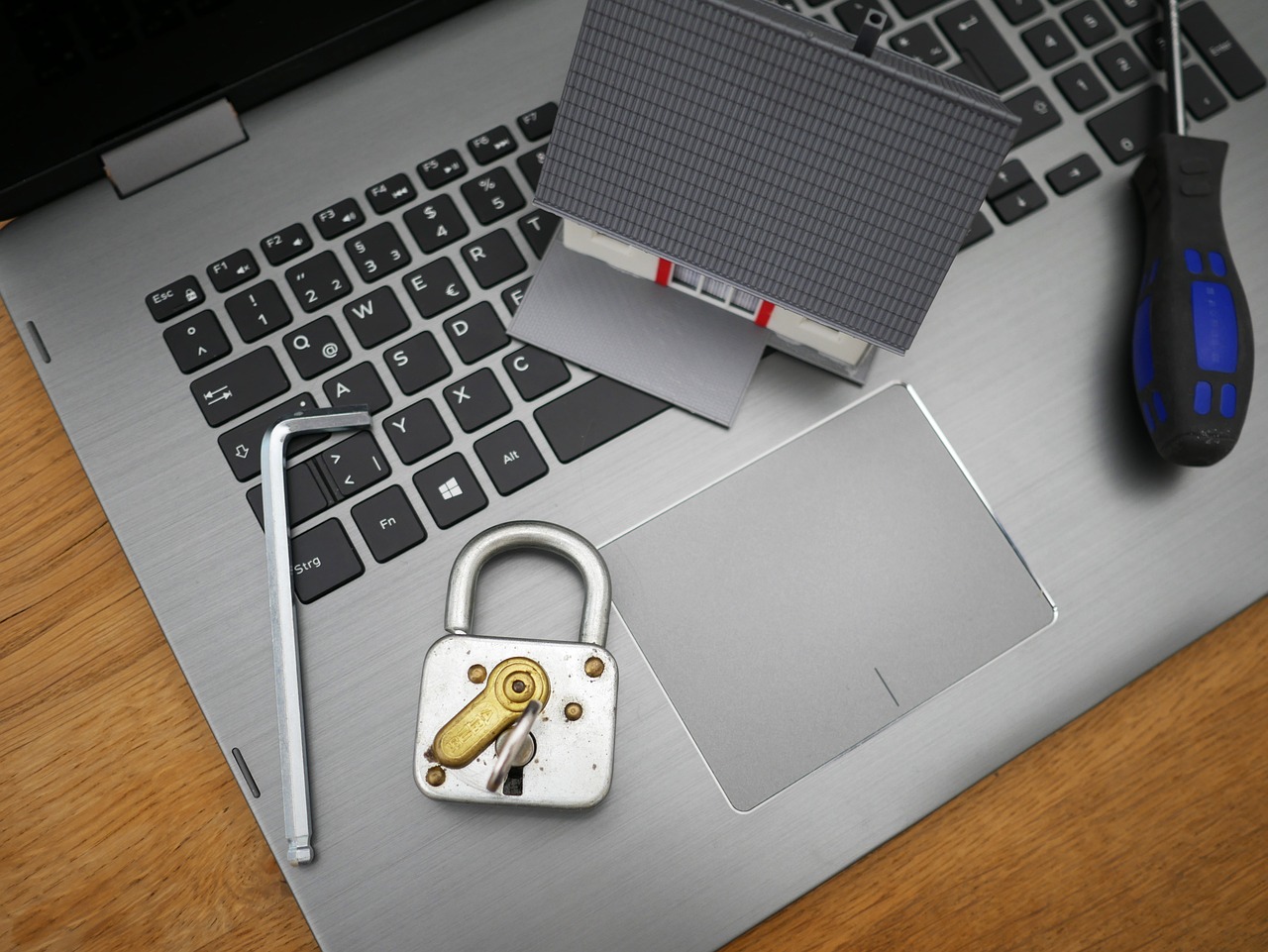
Order fees are costs that can surprise you if you do not watch out. When you make a sale, platforms and payment providers take some of your money. These fees might seem small at first. But they add up fast and can lower your profits.
Each place you sell has its own way to charge order fees. Some take a part of every sale. Others add a set fee on top. Payment providers like Payoneer or Stripe also have their own transaction fees. If you sell on big sites like Amazon or eBay, the fees are even higher. They charge more because you use their platform.
Here is a table to show how these fees compare on popular platforms:
Fee Type | Platform/Provider | Fee Range/Amount | Impact on Profit Margins |
|---|---|---|---|
Selling Channel Fees | Amazon | 8-15% referral fee + variable closing fee | Increases cost per order, reducing margins |
eBay | 12.9%-15% final value fee + insertion fee | Higher percentage fees reduce net profit | |
Etsy | $0.20 listing fee + 6.5% transaction fee | Fixed and percentage fees add to per-order costs | |
Shopify | 2.9% + $0.30 per transaction + monthly fee | Transaction fees and subscription reduce margins | |
TikTok Shop | 2-4% selling fee + 2% transaction fee | Combined fees can exceed 4% per order | |
Payment Provider Fees | Payoneer | 3% credit card transaction fee | Additional per-order cost impacting profitability |
Shipping Costs | Varies | Variable, plus taxes and customs duties (avg. 5.63%) | Significant cost that can erode margins if not managed |
Most order fees are a few percent to over 15% of the order value. If you sell products with low profit, these fees can take away all your earnings. For example, if you sell a £20 item on eBay, you might pay up to £3 in fees. This is before you pay for shipping or the product itself.
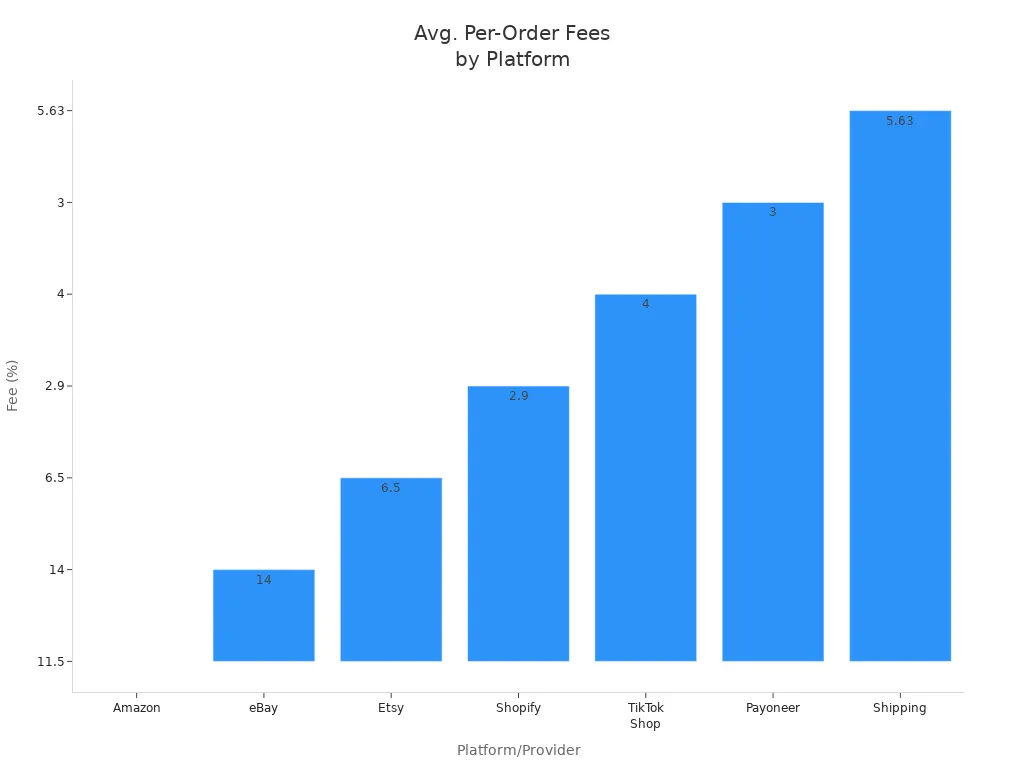
Tip: Always look at the fee structure before you choose a platform. Some platforms seem cheap but have hidden costs that appear later.
Some suppliers also charge their own order processing fees. These can be from £2 to £15 for each order. This is common if you use a dropshipping agent or a private supplier. If you want special packaging or faster shipping, you may pay even more.
Here are some ways these order fees can affect your business:
Lower profit margins: High fees mean you keep less money from each sale.
Harder to compete on price: If your fees are high, you may need to raise prices. This can make it harder to get customers.
Cash flow issues: Some platforms hold your money for days or weeks. This can slow down how fast you can use your money again.
You can handle these Dropshipping Expenses by checking platforms, talking to suppliers, and watching your numbers. If you know your order fees, you can set prices to make sure you still make a profit.
Operational Costs
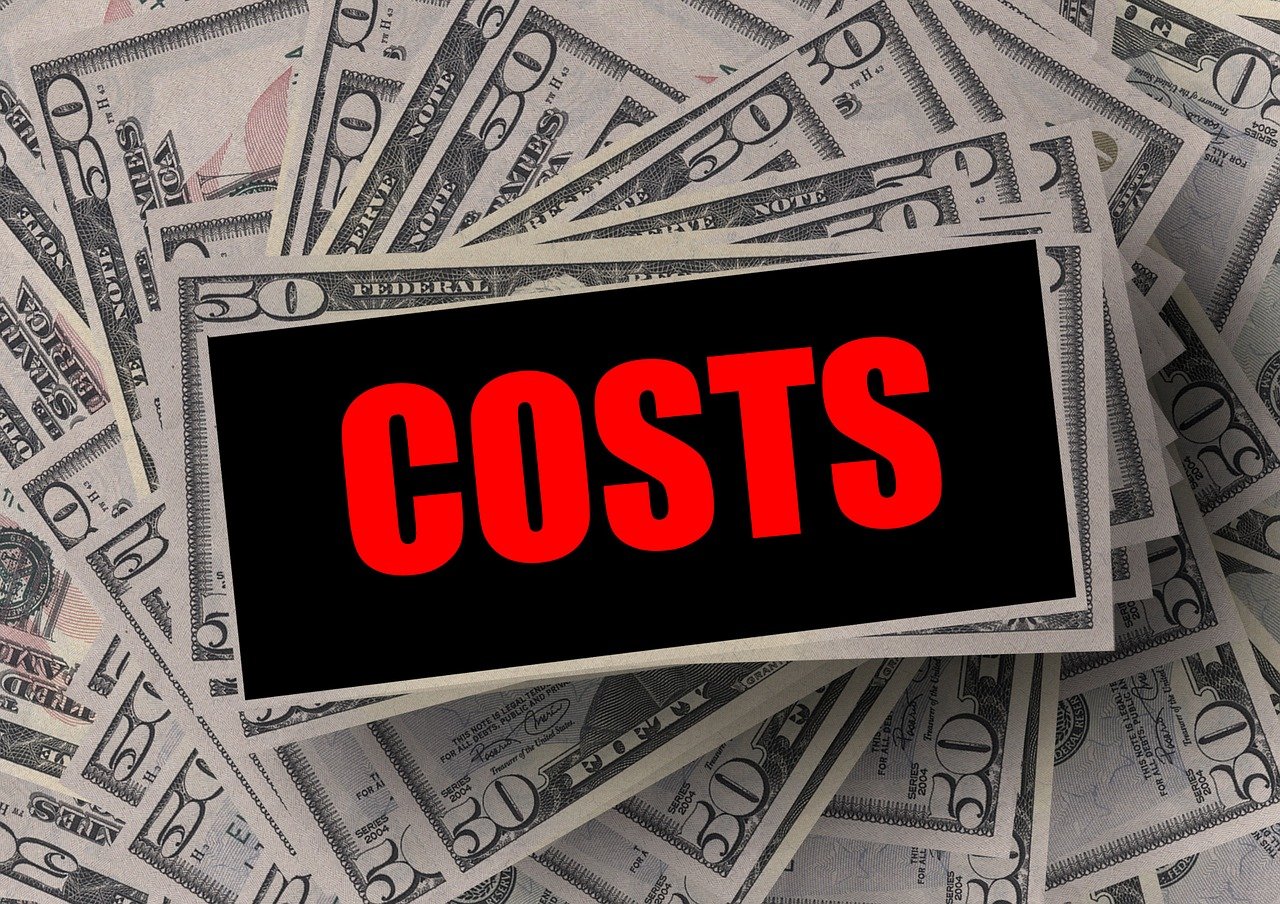
Apps and Tools
You need apps and tools to run your dropshipping shop well. These help you find products and manage orders. They also make some jobs automatic. Some tools are free, but most cost money each month. Picking the right ones saves time and money.
Here is a table with popular dropshipping apps and what they cost each month:
App/Tool | Description/Use Case | Typical Monthly Cost (USD) |
|---|---|---|
Shopify | E-commerce platform to build and run dropshipping stores | $29 (Basic), $79 (Shopify), $299 (Advanced) |
Oberlo | Shopify app to import and sync products from suppliers | Free starter; $29.90 (Basic); $79.90 (Pro) |
WooCommerce | Free WordPress plugin to create e-commerce stores | Free (plugin), hosting costs apply |
Spocket | Connects stores with suppliers, mainly US/Europe | $24 (Starter), $49 (Pro), $99 (Empire) |
AutoDS | Automates stock, pricing, tracking for Shopify & eBay | Starting at $6.33, scales with product count |
Dropified | Automates dropshipping processes, supports branding | $14 (Import), $168 (Private Label) |
SaleHoo | Wholesale directory and market research | $67/year or $127 lifetime |
Zapier | Automates workflows between apps | Free plan available; paid plans vary |
AliDropship | Connects to suppliers, one-time payment | $89 one-time; $299 for website creation |
Chili-Hunter | Market research for eBay dropshipping | $39.99/month or $16.66/month (annual billing) |
Ali Orders AliExpress Dropship | Product import and order automation for AliExpress | Free; $9.90 (Starter); $19.90 (Basic); $99.90 (Premium) |
Dropshipman | Product sourcing, fulfilment, branding | Free; $29.90 (Pro); $49.90 (Plus) |
If you use many tools, costs can rise fast. Some apps have free plans, but you may need to pay more as your shop gets bigger.
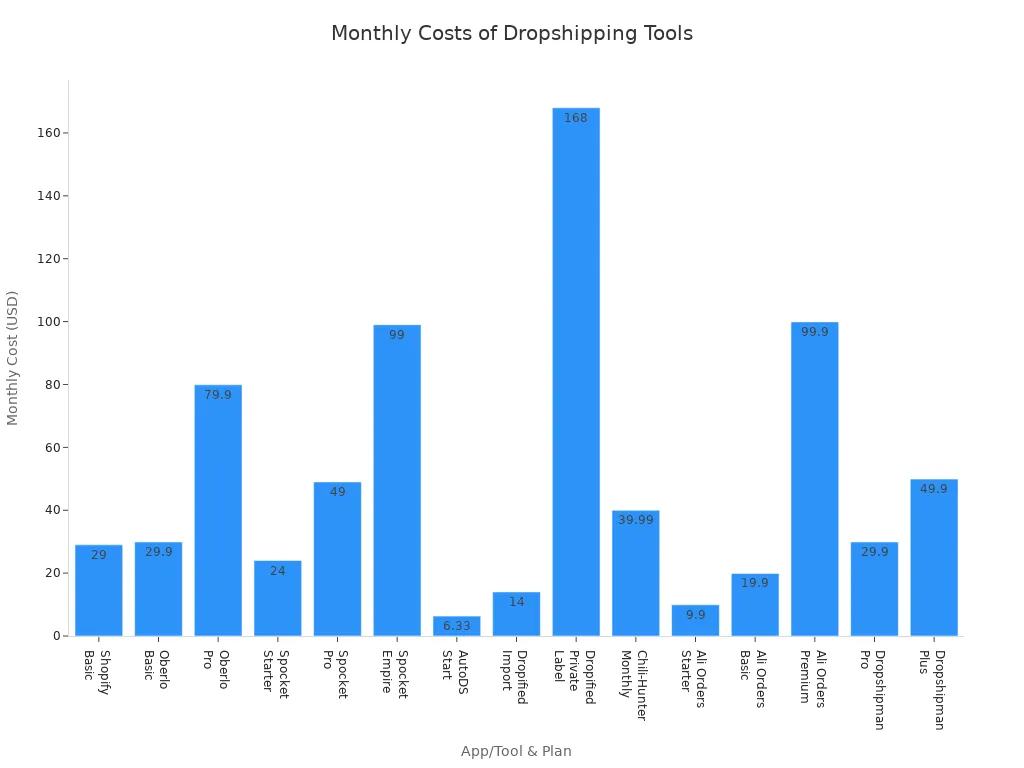
Tip: Only start with the apps you really need. Add more later when your business grows and you know what works.
Transaction Fees
When you sell something, payment processors like Stripe and PayPal take a fee. These fees look small, but they can lower your profits if you do not plan for them. Most dropshipping shops pay between 2.9% and 3.5% per sale, plus a small set fee.
Here is a table showing the usual fees:
Fee Type | Stripe Fee | PayPal Fee |
|---|---|---|
Standard Transaction | 2.9% + $0.30 per card payment | About 2.99% + $0.49 per transaction |
Chargeback Fee | $15 | $20 |
International Fees | Higher percentage applies | Higher percentage and fixed fees |
Invoicing Fees | 0.4% of payment | 2.99% + fixed fee |
If you sell to people in other countries, you will pay more. Some payment processors also charge for things like chargebacks or changing money to another currency.
Note: Always check the latest fees before you pick a payment provider. Fees can change, and some give discounts if you have lots of sales.
Customer Service

Good customer service keeps buyers happy and brings them back. At first, you might answer questions yourself. When you get more orders, you may need help. Many dropshipping owners hire virtual assistants or use customer support apps.
Here are some ways to handle customer service:
Use live chat apps like Tidio or Zendesk. These cost about $10–$50 each month.
Hire a virtual assistant. They usually cost $3–$8 per hour.
Set up automatic email replies for common questions.
If you ignore customer service, you could get bad reviews and lose sales. Spending a little on support can save money later.
Keeping track of all these operational costs is important. Dropshipping Expenses do not end after you open your shop. You must budget for apps, transaction fees, and customer support every month.
Maintenance
Keeping your dropshipping store running smoothly takes more than just launching it. You need to look after your website every month. This means checking for updates, fixing small problems, and making sure your shop stays safe for customers. If you skip maintenance, your site can slow down or even stop working. That can cost you sales and damage your reputation.
Let’s talk about the main things you need to maintain:
Hosting: This is where your website lives online. Good hosting keeps your shop fast and always available. Basic hosting plans for small shops usually cost between $5 and $15 each month. If your store grows or you want more features, you might pay $20 to $40 or more per month.
Security Updates: You must keep your site safe from hackers. Most hosting plans include an SSL certificate, which protects your customers’ data. Some hosts update your site for you, but sometimes you need to do it yourself. If you use WordPress or WooCommerce, you should update plugins and themes often.
Domain Renewal: Your domain name is your shop’s address. You pay for this every year, usually about $10 to $15. Some hosting plans include the domain fee.
Technical Support: Sometimes things break or you need help. You might hire a webmaster for a few hours each month. This can cost around $100 per month for small shops. Bigger stores might spend more if they need extra help.
Plugins and Tools: Many shops use extra tools for better features. Some are free, but others charge a monthly fee. These can add $0 to $50 or more to your monthly costs.
Here’s a table to show what you might pay each month for maintenance:
Website Type | Maintenance Cost | Hosting | SSL | Plugins/Tools | Webmaster Fees |
|---|---|---|---|---|---|
Small Ecommerce Store | $30 - $35 | ~$30 | Included | Included | ~$100 (few hours) |
Professional Ecommerce | $80 - $150 | ~$80 | $0-$10 | $0-$50 | $100-$500 |
Enterprise Ecommerce | $300 - $1000 | ~$300 | $0-$10 | $100-$200 | $100-$500+ |
Most dropshipping stores start as small ecommerce sites. You can expect to spend about $30 to $150 each month for hosting, security, and updates. If you want a professional look or more features, your costs will be higher.
Tip: Set a reminder to check your site every week. Update your plugins, test your checkout, and back up your data. This keeps your shop safe and running well.
Regular maintenance helps you avoid big problems. It also keeps your customers happy and your business growing.
Marketing and Advertising
Paid Ads
Paid ads are one of the fastest ways to get visitors to your shop. You can use platforms like Facebook, Instagram, Google, or TikTok. Most new dropshipping businesses start with a small daily budget. You might spend between $10 and $30 each day. This helps you test which products and ads work best. As you learn and see results, you can increase your daily spend up to $200 or more. If you look at it monthly, your ad spend could range from about $300 to $6,000, depending on how much you want to scale.
Start with a small daily budget to test ads.
Increase your spend as you find winning products.
Track your results so you do not waste money.
Tip: Paid ads can eat up your budget quickly. Always set a limit and check your ad performance every day.
Influencer Marketing
Influencer marketing is a smart way to reach new customers. You work with people who have followers on social media. They talk about your products and help build trust. Micro and nano influencers (with 1,000 to 100,000 followers) are great for dropshipping. They often have high engagement and do not charge as much as big celebrities.
Here is a quick look at influencer marketing for dropshipping:
Aspect | Details |
|---|---|
Effectiveness | Builds trust, targets specific audiences, increases engagement, and provides social proof. |
Ideal Influencers | Micro (10K-100K followers) and Nano (1K-10K followers) offer high engagement and affordability. |
Example Cost | YouTube sponsored content can cost $2,500+ per video for larger influencers. |
Cost Structure | Nano/micro influencers often accept free products or commission-based pay. |
Budget Tips | Start small, use gifting, performance-based pay, and work with several micro-influencers. |
You do not need a huge budget to start. Many small influencers will promote your product for a free sample or a small commission on sales. This keeps your costs low and helps you reach the right people. If you want to track your results, set clear goals like more sales or more followers.
Build relationships with influencers before you launch a campaign.
Use affiliate links or codes to track sales.
Focus on influencers who match your brand values.
Email Marketing
Email marketing is a powerful tool for dropshipping shops. It helps you keep in touch with customers, share offers, and bring people back to your store. The cost depends on how many people you email each month. Many platforms offer free plans for small lists. If you have up to 1,000 contacts, you might pay nothing or up to $39 per month. For 5,000 contacts, expect to pay up to $99 per month. As your list grows, costs rise, but so does your chance to make more sales.
Email List Size | Typical Price Range (USD/month) | Average Cost (USD/month) |
|---|---|---|
Up to 1,000 | $0 to $39 | $18 |
Around 5,000 | $0 to $99 | $62 |
Around 10,000 | $25 to $155 | $100 |
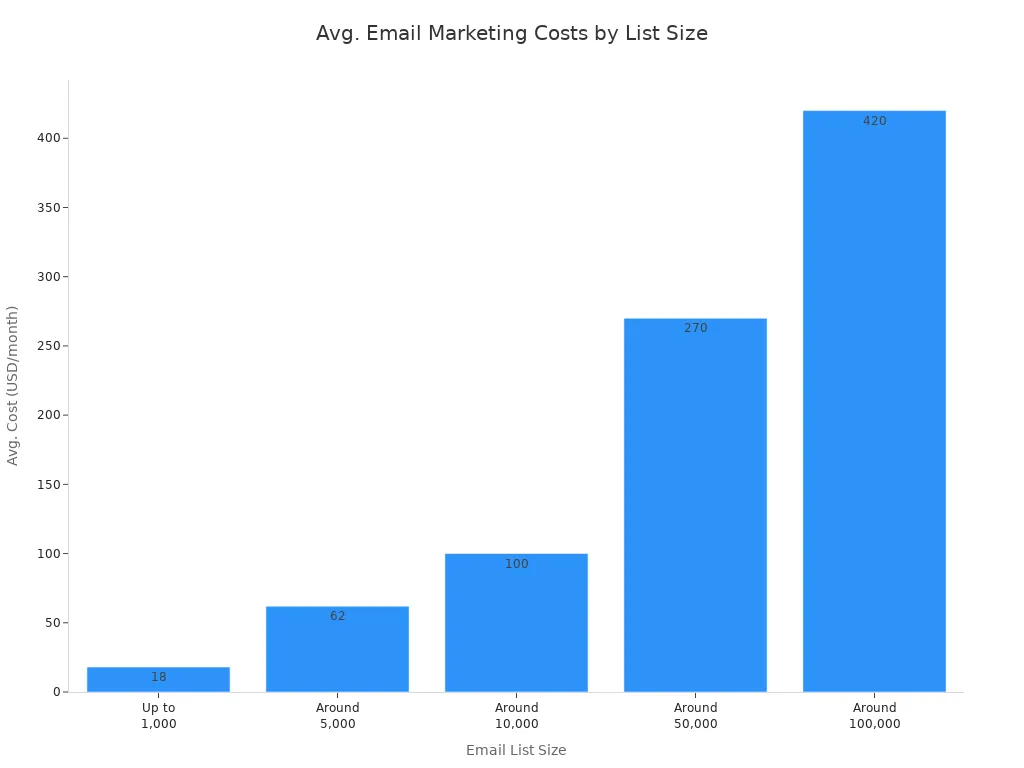
Note: Most email platforms let you start for free. Upgrade only when your list grows or you need more features.
Content Creation
Content creation helps your dropshipping shop stand out from the crowd. When you make your own content, you build trust and show your brand’s personality. You do not need to be a professional writer or photographer to get started. You just need to know what your customers want to see.
You can create many types of content for your store:
Product photos: Take clear pictures of your products. Use natural light and simple backgrounds. If you cannot take your own photos, ask your supplier for high-quality images.
Product videos: Short videos show how your product works. You can film a quick demo with your phone. Videos help customers understand what they are buying.
Blog posts: Write simple guides or answer common questions. For example, you can write about how to use your products or share tips for choosing the right item.
Social media posts: Share updates, behind-the-scenes photos, or customer reviews. Use platforms like Instagram, Facebook, or TikTok to reach more people.
User-generated content: Ask your customers to share photos or videos of your products. You can offer a small discount or run a contest to encourage them.
Content creation does not have to cost a lot. You can start with free tools like Canva for graphics or your phone for photos and videos. If you want to save time, you can hire a freelancer. Many freelancers charge between £10 and £50 per project. Some content, like blog posts or product descriptions, can be written by you at no extra cost.
Here’s a quick table to help you plan your content budget:
Content Type | DIY Cost | Outsourcing Cost |
|---|---|---|
Product Photos | Free (your phone) | £20–£100 per shoot |
Product Videos | Free–£10 | £30–£150 per video |
Blog Posts | Free | £10–£40 per post |
Social Media Posts | Free | £5–£20 per post |
Graphics/Designs | Free (Canva) | £10–£50 per design |
Tip: Start small. Focus on one or two types of content first. As your shop grows, you can add more.
Good content helps you attract visitors and turn them into buyers. It also makes your brand look more professional. If you plan your content and budget for it, you will avoid surprise costs and keep your Dropshipping Expenses under control.
Shipping and Returns
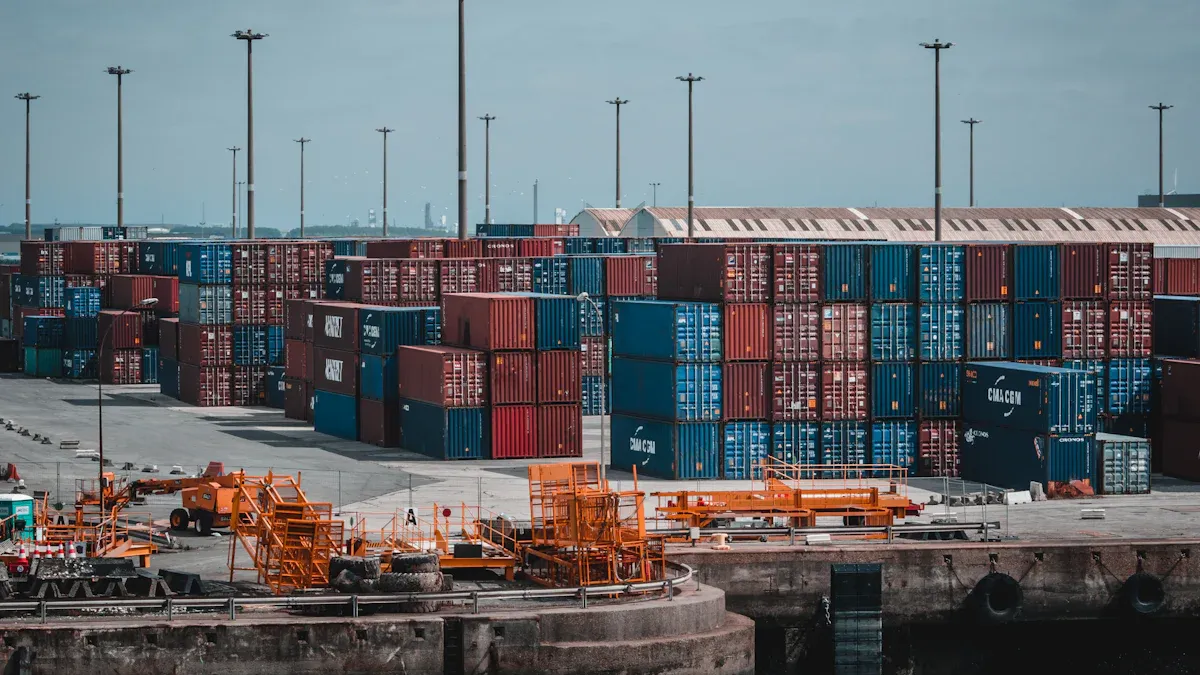
Shipping Fees
Shipping costs can make or break your dropshipping business. You need to know how much you will pay for each order, both at home and abroad. Domestic shipping is usually cheaper and more predictable. International shipping costs more and can change a lot depending on the country and weight.
Here’s a quick look at typical shipping fees:
Order Type | Weight Range | Shipping Fee Range (USD) |
|---|---|---|
Domestic (US) | Up to 0.6 lb | Around $3.99 |
Domestic (US) | Up to 1 lb | $5.99 - $6.74 |
Domestic (US) | Up to 5 lb | $9.99 - $17.47 |
Domestic (US) | Above 5 lb | Up to $14.99 |
International | Up to 2 lb | Starting at $7.97 |
International | 2 - 10 lb | $8.69 - $14.81 |
International | 11 - 21 lb | $15.79 - $26.58 |
International | 22 - 32 lb | $26.97 - $35.12 |
International shipping always starts higher and goes up quickly with weight. You also need to think about extra costs like handling and packaging. These can add $1 to $5 per order. Some suppliers charge a handling fee based on how long it takes to pack an order.
Tip: Always check your supplier’s shipping rates before you set your prices. If you sell to other countries, add a buffer for customs and unexpected fees.
Returns
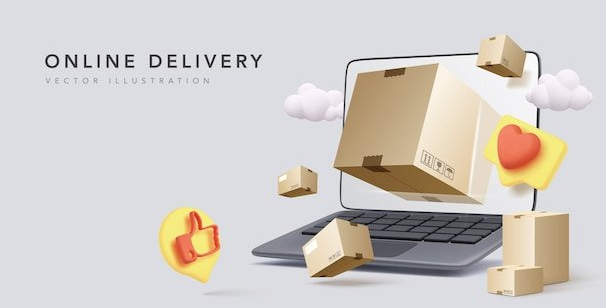
Returns are part of running a shop, but they can get expensive if you do not plan ahead. Over 63% of dropshipping shops ask customers to pay for return shipping. Sometimes, the cost to send an item back is more than the item itself. For cheap products, it might be better to give a refund and let the customer keep the item.
Here are some ways to manage return shipping and restocking costs:
Write a clear return policy and share it on your website.
Offer returnless refunds for low-value items.
Encourage exchanges instead of returns.
Use return labels to make the process easy.
Negotiate better shipping rates with carriers.
Watch out for return fraud.
Suppliers have their own rules about returns and restocking fees. Some want photos before they accept a return. Others charge a fee to check and restock the item. You need to match your policy with your supplier’s rules to avoid delays and extra costs.
Note: If you pay the return shipping or restocking fee, your profit drops. Always check who pays these fees—sometimes it’s you, sometimes the customer.
Refunds
Refunds can hurt your profits if you do not control them. Dropshipping makes refunds tricky because you do not hold the stock. You must talk to both the customer and the supplier. High refund rates mean you pay more for shipping, restocking, and sometimes lose the sale altogether.
Free returns sound good, but they can eat into your margins. You can offer partial refunds, store credit, or set rules for returns to protect your business.
Work with suppliers who have fair and fast return processes. This saves you time and keeps customers happy.
Use software to automate refunds and returns. This cuts down on mistakes and makes things smoother for everyone.
Watch your return and refund trends. If you see lots of returns for one product, it might be time to drop it or find a better supplier.
Hidden costs can sneak up on you. Sometimes you need to send a replacement without getting the original back, which means you lose money. Mistakes like wrong shipments or lost packages also add to your costs. Investing in a good returns system helps you save time and keeps your customers coming back.
Tip: Always include return and refund costs in your pricing. This helps you stay profitable, even when things go wrong.
Ongoing and Hidden Costs
Taxes
You might think taxes are simple, but they can get tricky with dropshipping. If you sell to customers in different countries, you need to know about VAT (Value Added Tax). Here’s what you should keep in mind:
You must charge VAT on sales to your final customers (B2C).
If you sell abroad and do not have a business set up in that country, you often need to register for VAT from your very first sale.
Many dropshippers register for VAT in each country where their customers live, or they use the OSS (One Stop Shop) scheme to make things easier.
The VAT rate depends on where your customer is based, not where you are.
If you import goods from outside the EU, you might need to use the IOSS scheme.
You must pay the VAT you collect to the tax authorities, either through country-specific returns or the OSS system.
Tip: Tax rules change often. Always check the latest rules for each country you sell to. If you ignore VAT, you could face fines or have your shop shut down.
Accounting
Keeping track of your money is just as important as making sales. Good bookkeeping helps you see where your money goes and keeps you out of trouble with the tax office. Here’s what you need to do:
Record every sale and expense, even small ones.
Save all your receipts and invoices.
Use simple accounting software or hire a bookkeeper if you do not like numbers.
Check your profit and loss each month to spot problems early.
A table can help you see what to track:
What to Track | Why It Matters |
|---|---|
Sales | Know your income |
Supplier payments | Track Dropshipping Expenses |
Platform fees | See how much you pay to sell |
Marketing spend | Measure your ad results |
Refunds/returns | Spot costly trends |
If you keep your books tidy, you will find it easier to manage VAT, pay your taxes, and plan for growth.
Scaling
As your shop grows, so do your costs. Some expenses are easy to see, but others can sneak up on you. Here are some hidden costs you might face when scaling your dropshipping business:
Packaging fees and restocking charges can rise as you sell more.
Some suppliers charge premium access fees or increase their prices without warning.
Marketing and advertising costs often go up, especially if you want to beat your competitors.
Payment processing fees and extra tools for automation can eat into your profits.
You might need to hire help for customer service or legal compliance.
Subscription fees for apps and hosting can increase as your store gets bigger.
Operational inefficiencies, like slow order handling, can cost you money without you noticing.
Watch your numbers closely. Dropshipping Expenses can spiral if you do not track every cost. Set a budget, review it often, and adjust as you grow.
Miscellaneous
You might think you have covered all your costs, but some expenses can still surprise you. These are the little things that do not fit into other categories but can add up over time. If you want to keep your business healthy, you need to watch out for these hidden costs.
1. Chargebacks and Payment Disputes
Sometimes, customers ask their bank to reverse a payment. This is called a chargeback. You might lose the sale and pay a fee, which can be £10 to £25 each time. Too many chargebacks can even get your payment account frozen. To avoid this, always provide clear product descriptions and fast customer service.
2. Currency Conversion Fees
If you sell to customers in other countries, payment processors may charge you for changing money. These fees are usually small, but they can eat into your profits if you do not notice them. Check your payment provider’s rates and try to price your products in the main currency of your customers.
3. Software Upgrades and Renewals
You might start with free or basic versions of apps and tools. As your shop grows, you may need to upgrade. Some tools charge yearly renewal fees. Always check when your subscriptions end so you do not get caught off guard.
4. Legal and Compliance Costs
You must follow the rules for online selling. Sometimes, you need to pay for privacy policies, cookie banners, or legal advice. If you ignore these, you could face fines or have your shop taken down.
5. Office Supplies and Equipment
Even if you work from home, you may need a printer, paper, or a better computer. These costs seem small, but they matter when you add them up.
Here’s a table to help you spot some common miscellaneous costs:
Expense Type | Typical Cost Range | How to Manage It |
|---|---|---|
Chargeback Fees | £10 – £25 per case | Reduce with good support |
Currency Conversion | 1% – 4% per transaction | Use local currency if possible |
Software Renewals | £10 – £100 per year | Track renewal dates |
Legal/Compliance | £0 – £200+ | Use templates, stay updated |
Office Supplies | £5 – £50 per month | Buy only what you need |
Tip: Keep a small emergency fund for these surprise costs. Review your expenses every month so nothing slips through the cracks.
If you track these extra costs, you will find it easier to stay profitable. Small expenses can pile up, but you can control them with good habits and regular checks.
Managing Dropshipping Expenses
Budgeting
If you want your dropshipping shop to last, you need a clear budget. Start by listing every cost you expect. This includes product costs, shipping, marketing, platform fees, and taxes. Use a simple spreadsheet or accounting software to track these numbers. Keep your business and personal money separate. This makes it easier to see where your money goes.
Check your expenses often. Look at your financial reports every week or month. This helps you spot problems early. Track your spending in real time. If you see costs rising, you can act fast. Always set aside money for taxes and unexpected bills. Many new shop owners forget about small fees or let them pile up. These can eat into your profits.
Here are some best practices for budgeting in dropshipping:
Use accounting software to track expenses automatically.
Keep business and personal accounts separate.
Review your costs and profits regularly.
Track all key expense categories, like product costs, marketing, and transaction fees.
Avoid mixing personal and business spending.
Tip: Never guess your numbers. Write down every cost, even the small ones.
Cost-Saving Tips
You can save money in many ways when running a dropshipping shop. First, talk to your suppliers. Ask for better prices or discounts, especially if you sell more. Compare different suppliers to find the best deal. Use automated tools to handle orders and stock. This cuts down on mistakes and saves time.
Try to keep your shipping and packaging costs low. Choose simple packaging and look for cheaper shipping options. Use social media to market your shop for free. Share posts, stories, and updates to reach more people without paying for ads. Focus on keeping your current customers happy. It costs less to keep a customer than to find a new one.
Here are some quick cost-saving ideas:
Negotiate with suppliers for better rates.
Use automation to reduce manual work.
Offer upsells and cross-sells to boost each order’s value.
Watch out for small, recurring charges from apps or tools.
Use free marketing channels like social media.
Profitability
To make a profit, you must know your numbers. Work out your minimum product price by adding up all your costs. This includes the product, shipping, platform fees, payment fees, and taxes. Add a margin so you earn money on each sale. If you do not include every cost, you might lose money without realising it.
Keep an eye on your cash flow. Make sure you have enough money to pay suppliers and cover returns or refunds. Use reports to see which products make the most profit. Drop products that cost too much or have high return rates. Always factor in transaction fees and taxes when you set your prices.
Here’s a simple table to help you set your minimum product price:
Cost Type | Example Amount (£) |
|---|---|
Product Cost | 10 |
Shipping | 3 |
Platform Fees | 1 |
Payment Fees | 0.50 |
Taxes | 2 |
Total Cost | 16.50 |
Add Profit Margin | +3.50 |
Minimum Price | 20 |
Remember, tracking Dropshipping Expenses closely helps you stay profitable and avoid nasty surprises.
You now know what it really costs to run a dropshipping shop. Startup and ongoing costs can add up, so always plan your budget. Watch out for hidden fees and keep track of every expense. Set clear goals, review your spending, and adjust your prices when needed. If you stay organised and check your numbers often, you can avoid surprises and keep your business profitable. Remember, good planning helps you succeed for the long term.
FAQ
How much money do I need to start dropshipping?
You can start with as little as £50–£100. This covers your domain, basic platform fees, and a small marketing budget. If you want to test more products or run ads, you might need a bit more.
Do I pay for products before customers order?
No, you only pay your supplier after a customer places an order in your shop. This means you do not need to buy stock upfront or worry about unsold items.
What hidden costs should I watch out for?
Look out for transaction fees, app subscriptions, chargebacks, and currency conversion charges. These small costs can add up quickly if you do not track them.
Can I run a dropshipping business without paid ads?
Yes, you can use free marketing methods like social media, SEO, and email. Paid ads help you grow faster, but you can start small and build up as you learn what works.
How do I handle returns and refunds?
You need a clear return policy. Talk to your supplier about their rules. Sometimes, it is cheaper to refund the customer and let them keep the item, especially for low-cost products.
Do I need to register for VAT or pay taxes?
Yes, you must follow tax rules in your country and where your customers live. You may need to register for VAT and file returns. Always check the latest tax laws or ask an accountant for help.
What if my dropshipping expenses go up suddenly?
Check your spending every week. If costs rise, look for cheaper tools, negotiate with suppliers, or cut back on ads. Keeping a close eye on your budget helps you stay profitable.

TangBuy: A Smarter Way to Dropship in 2025
If you're looking to stay competitive with dropshipping in 2025, speed and trend-awareness are key. TangBuy helps you stay ahead with real-time product trends, fast fulfilment, and factory-direct sourcing. With over 1 million ready-to-ship items, 24-hour order processing, and seamless Shopify integration, TangBuy makes it easier to test, scale, and succeed in today's fast-moving eCommerce landscape.
See Also
Understanding The Real Expenses Of Dropshipping In 2025
Required Capital To Begin Amazon Dropshipping Successfully
Ways To Manage Shipping Expenses In Dropshipping Ventures
Essential Advice For eBay Dropshipping Sellers To Succeed 2025
